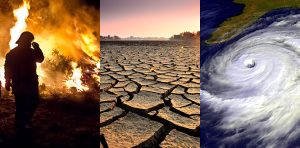“Something wicked this way comes”: 10 Reasons why climate change as a “wicked problem”
We often hear that climate change is a “wicked problem”. But what does that mean? And what are the implications of a “wicked problem” for a Master’s Program in Climate Change & Society?

Although “wicked problem” sounds trendy, the term goes back more than 50 years, and we know exactly when and where it was coined. In 1973, two scholars of planning, Horst Rittel and Melvin Webber (both at Berkeley) wrote a paper: “Dilemmas in a General Theory of Planning”. Starting from G. B. Shaw’s acerbic observation that “…every profession is a conspiracy against the laity”, they go on to describe the challenges of planning in a world where the simple problems – how to build a road, deliver safe water, carry off waste in sewers – have been solved (or are deemed solvable), and where the planner trying to address new and emerging problems confronts conflicting values, deep complexity, and an absence of agreed upon goals: what does a solution look like?
But the most quoted section of the paper is where Rittel & Webber lay out the 10 key features of a “wicked problem” (paraphrasing):
- It is ill defined
- It goes on and on – there is no point where we can say it is solved
- Its solutions are measured against values
- Its solutions are not readily testable
- Its solutions that are “one-off” and cannot be improved by trial-and-error
- Its possible solutions are not confined to a well-defined set
- It is unique
- It can be seen as a symptom of other bigger problems
- It has multiple possible sources
- There is no room for error in planning a solution
Is climate change truly a wicked problem? Does it fit these criteria? Probably not, if you think of climate change as purely physical: Earth warms due to the enhanced greenhouse effect of human-produced heat trapping gases. This is safely in the realm of enlightenment physics. We compute, with confidence, the consequences of our emissions, and the solution is clear: emit less CO2 and methane. Done and done.
But when we start to talk about how to reduce emissions while, at the same time, we strive to provide sufficient food, water, and energy for 8+ billion people and raise 2 or 3 billion people out of poverty, then climate change surely is a wicked problem.
Matching climate change to all of the10 criteria for a wicked problem is “left as an exercise”. I’ll mention just a few that demonstrate the value of the broad multidisciplinary understanding of climate change that students develop in the CCS program.
Wicked-problem feature #3 (above) says we need people who can evaluate climate change solutions – adaptation and mitigation – from many perspectives, cultural, political, and economic. #4 & #5 say solutions must be tested in models; we need people to build those models and, even more importantly, to critically evaluate their outputs. In pointing out that wicked problems are linked, #8 calls for people with the wisdom to consider climate change solutions in the greater contexts of social and economic equity, justice, and sustainability.
And while #10 is a little scary (you’d better not get it wrong!), #1 says you’ll have a job forever!
Finally, it is becoming clear that all the great problems of the 21st century, the problems worth spending a lifetime working on, are wicked problems, and that they are all connected. Interdisciplinary preparation to work on one of them prepares a person to work on all of them. And this is precisely what is needed if one is to do the greatest and most necessary work of our time.